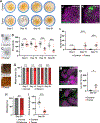Systemic coagulopathy promotes host lethality in a new Drosophila tumor model
- PMID: 37354901
- PMCID: PMC11365082
- DOI: 10.1016/j.cub.2023.05.071
Systemic coagulopathy promotes host lethality in a new Drosophila tumor model
Abstract
Malignant tumors trigger a complex network of inflammatory and wound repair responses, prompting Dvorak's characterization of tumors as "wounds that never heal."1 Some of these responses lead to profound defects in blood clotting, such as disseminated intravascular coagulopathy (DIC), which correlate with poor prognoses.2,3,4 Here, we demonstrate that a new tumor model in Drosophila provokes phenotypes that resemble coagulopathies observed in patients. Fly ovarian tumors overproduce multiple secreted components of the clotting cascade and trigger hypercoagulation of fly blood (hemolymph). Hypercoagulation occurs shortly after tumor induction and is transient; it is followed by a hypocoagulative state that is defective in wound healing. Cellular clotting regulators accumulate on the tumor over time and are depleted from the body, suggesting that hypocoagulation is caused by exhaustion of host clotting components. We show that rescuing coagulopathy by depleting a tumor-produced clotting factor improves survival of tumor-bearing flies, despite the fact that flies have an open (non-vascular) circulatory system. As clinical studies suggest that lethality in patients with high serum levels of clotting components can be independent of thrombotic events,5,6 our work establishes a platform for identifying alternative mechanisms by which tumor-driven coagulopathy triggers early mortality. Moreover, it opens up exploration of other conserved mechanisms of host responses to chronic wounds.
Keywords: Tumor-host; carcinoma; clotting; coagulopathy; drosophila; innate immunity; ovarian cancer; paraneoplasia; pre-clinical disease model; wound response.
Copyright © 2023 Elsevier Inc. All rights reserved.
Conflict of interest statement
Declaration of interests The authors declare no competing interests.
Figures




References
-
- Dvorak HF (1986). Tumors: Wounds that do not heal. N Engl J Med 315, 1650–1659. - PubMed
-
- Levi M, and ten Cate H (1999). Disseminated Intravascular Coagulation. N Engl J Med 341, 586–592. - PubMed
-
- Krenn-Pilko S, Langsenlehner U, Stojakovic T, Pichler M, Gerger A, Kapp KS, and Langsenlehner T (2015). An elevated preoperative plasma fibrinogen level is associated with poor disease-specific and overall survival in breast cancer patients. Breast 24, 667–672. 10.1016/j.breast.2015.08.003. - DOI - PubMed
Publication types
MeSH terms
Grants and funding
LinkOut - more resources
Full Text Sources
Molecular Biology Databases
Research Materials

